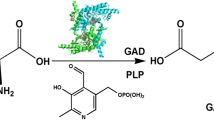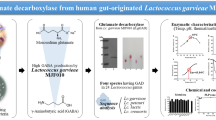Abstract
Gamma-aminobutyric acid (GABA), an important bioactive compound, is synthesized through the decarboxylation of L-glutamate (L-Glu) by glutamate decarboxylase (GAD). The use of lactic acid bacteria (LAB) as catalysts opens interesting avenues for the biosynthesis of food-grade GABA. However, a key obstacle involved in the improvement of GABA production is how to resolve the discrepancy of optimal pH between the intracellular GAD activity and cell growth. In this work, a potential GAD candidate (LpGadB) from Lactobacillus plantarum was heterologously expressed in Escherichia coli. Recombinant LpGadB existed as a homodimer under the native conditions with a molecular mass of 109.6 kDa and exhibited maximal activity at 40°C and pH 5.0. The Km value and catalytic efficiency (kcat/Km) of LpGadB for L-Glu was 21.33 mM and 1.19 mM−1s−1, respectively, with the specific activity of 26.67 μM/min/mg protein. Subsequently, four C-terminally truncated LpGadB mutants (GadBΔC10, GadBΔC11, GadBΔC12, GadBΔC13) were constructed based on homology modeling. Among them, the mutant GadBΔC11 with highest catalytic activity at near-neutral pH values was selected. In further, the GadBΔC11 and Glu/GABA antiporter (GadC) of Lactococcus lactis were co-overexpressed in the host L. lactis NZ3900. Finally, after 48 h of batch fermentation, the engineered strain L. lactis NZ3900/pNZ8149-gadBΔC11C yielded GABA concentration up to 33.52 g/L by applying a two-stage pH control strategy. Remarkably, this is the highest yield obtained to date for GABA from fermentation with L. lactis as a microbial cell factory.
Key points
• The GadB from L. plantarum was heterologously expressed in E. coli and biochemically characterized.
• Deletion of the C-plug in GadB shifted its pH-dependent activity toward a higher pH.
• Reconstructing the GAD system of L. lactis is an effective approach for improving its GABA production.








Similar content being viewed by others
Data availability
All data and materials are available upon reasonable request.
References
Bhanwar S, Bamnia M, Ghosh M, Ganguli A (2013) Use of Lactococcus lactis to enrich sourdough bread with gamma-aminobutyric acid. Int J Food Sci Nutr 64(1):77–81. https://doi.org/10.3109/09637486.2012.700919
Capitani G, De Biase D, Aurizi C, Gut H, Bossa F, Grutter MG (2003) Crystal structure and functional analysis of Escherichia coli glutamate decarboxylase. EMBO J 22(16):4027–4037. https://doi.org/10.1093/emboj/cdg403
Cui Y, Miao K, Niyaphorn S, Qu X (2020) Production of gamma-aminobutyric acid from lactic acid bacteria: a systematic review. Int J Mol Sci 21(3). https://doi.org/10.3390/ijms21030995
Dhakal R, Bajpai VK, Baek KH (2012) Production of GABA (gamma-aminobutyric acid) by microorganisms: a review. Braz J Microbiol 43(4):1230–1241. https://doi.org/10.1590/S1517-83822012000400001
Dutyshev DI, Darii EL, Fomenkova NP, Pechik IV, Polyakov KM, Nikonov SV, Andreeva NS, Sukhareva BS (2005) Structure of Escherichia coli glutamate decarboxylase (GADα) in complex with glutarate at 2.05 Ȧ resolution. Acta Crystallogr D Biol Crystallogr 61(3):230–235. https://doi.org/10.1107/S0907444904032147
Feehily C, Karatzas KA (2013) Role of glutamate metabolism in bacterial responses towards acid and other stresses. J Appl Microbiol 114(1):11–24. https://doi.org/10.1111/j.1365-2672.2012.05434.x
Franciosi E, Carafa I, Nardin T, Schiavon S, Poznanski E, Cavazza A, Larcher R, Tuohy KM (2015) Biodiversity and gamma-aminobutyric acid production by lactic acid bacteria isolated from traditional alpine raw cow’s milk cheeses. Biomed Res Int 2015:625740. https://doi.org/10.1155/2015/625740
Guerois R, Nielsen JE, Serrano L (2002) Predicting changes in the stability of proteins and protein complexes: a study of more than 1000 mutations. J Mol Biol 320(2):369–387. https://doi.org/10.1016/S0022-2836(02)00442-4
Gut H, Pennacchietti E, John RA, Bossa F, Capitani G, De Biase D, Grutter MG (2006) Escherichia coli acid resistance: pH-sensing, activation by chloride and autoinhibition in GadB. EMBO J 25(11):2643–2651. https://doi.org/10.1038/sj.emboj.7601107
Huang J, Fang H, Gai ZC, Mei JQ, Li JN, Hu S, Lv CJ, Zhao WR, Mei LH (2018) Lactobacillus brevis CGMCC 1306 glutamate decarboxylase: crystal structure and functional analysis. Biochem Bioph Res Co 503(3):1703–1709. https://doi.org/10.1016/j.bbrc.2018.07.102
Komatsuzaki N, Nakamura T, Kimura T, Shima J (2008) Characterization of glutamate decarboxylase from a high gamma-aminobutyric acid (GABA)-producer, Lactobacillus paracasei. Biosci Biotechnol Biochem 72(2):278–285. https://doi.org/10.1271/bbb.70163
Laroute V, Yasaro C, Narin W, Mazzoli R, Pessione E, Cocaign-Bousquet M, Loubiere P (2016) GABA Production in Lactococcus lactis is enhanced by arginine and co-addition of malate. Front Microbiol 7:7. https://doi.org/10.3389/Fmicb.2016.01050
Li H, Cao Y (2010) Lactic acid bacterial cell factories for gamma-aminobutyric acid. Amino Acids 39(5):1107–1116. https://doi.org/10.1007/s00726-010-0582-7
Lu XX, Chen ZG, Gu ZX, Han YB (2008) Isolation of gamma-aminobutyric acid-producing bacteria and optimization of fermentative medium. Biochem Eng J 41(1):48–52. https://doi.org/10.1016/j.bej.2008.03.005
Lu XX, Xie CY, Gu ZX (2009) Optimisation of fermentative parameters for GABA enrichment by Lactococcus lactis. Czech J Food Sci 27(6):433–442. https://doi.org/10.17221/45/2009-CJFS
Lyu C-J, Fei J-Y, Yan J-P, Xu Q-C, Mei J-Q, Yue H-Y, Chen L-L, Mei L-H, Huang J, Yao S-J (2020) Improvement of γ-aminobutyrate biosynthesis by genetically engineered Lactococcus lactis. Biochem Eng J 157:107525. https://doi.org/10.1016/j.bej.2020.107525
Lyu CJ, Zhao WR, Hu S, Huang J, Lu T, Jin ZH, Mei LH, Yao SJ (2017) Physiology-oriented engineering strategy to improve gamma-aminobutyrate production in Lactobacillus brevis. J Agric Food Chem 65(4):858–866. https://doi.org/10.1021/acs.jafc.6b04442
Ma D, Lu P, Yan C, Fan C, Yin P, Wang J, Shi Y (2012) Structure and mechanism of a glutamate-GABA antiporter. Nature 483(7391):632–636. https://doi.org/10.1038/nature10917
Marquez FJ, Quesada AR, Sanchez-Jimenez F, Nunez de Castro I (1986) Determination of 27 dansyl amino acid derivatives in biological fluids by reversed-phase high-performance liquid chromatography. J Chromatogr 380(2):275–283. https://doi.org/10.1016/s0378-4347(00)83656-7
Mazzoli R, Pessione E, Dufour M, Laroute V, Giuffrida MG, Giunta C, Cocaign-Bousquet M, Loubiere P (2010) Glutamate-induced metabolic changes in Lactococcus lactis NCDO 2118 during GABA production: combined transcriptomic and proteomic analysis. Amino Acids 39(3):727–737. https://doi.org/10.1007/s00726-010-0507-5
Miller SR (2017) An appraisal of the enzyme stability-activity trade-off. Evolution 71(7):1876–1887. https://doi.org/10.1111/evo.13275
Molina-Gutierrez A, Stippl V, Delgado A, Ganzle MG, Vogel RF (2002) In situ determination of the intracellular pH of Lactococcus lactis and Lactobacillus plantarum during pressure treatment. Appl Environ Microbiol 68(9):4399–4406. https://doi.org/10.1128/aem.68.9.4399-4406.2002
Ngo DH, Vo TS (2019) An updated review on pharmaceutical properties of gamma-aminobutyric acid. Molecules 24(15). https://doi.org/10.3390/molecules24152678
Nomura M, Kimoto H, Someya Y, Furukawa S, Suzuki I (1998) Production of gamma-aminobutyric acid by cheese starters during cheese ripening. J Dairy Sci 81(6):1486–1491. https://doi.org/10.3168/jds.S0022-0302(98)75714-5
Rizzello CG, Cassone A, Di Cagno R, Gobbetti M (2008) Synthesis of angiotensin I-converting enzyme (ACE)-inhibitory peptides and gamma-aminobutyric acid (GABA) during sourdough fermentation by selected lactic acid bacteria. J Agric Food Chem 56(16):6936–6943. https://doi.org/10.1021/jf800512u
Sanders JW, Leenhouts K, Burghoorn J, Brands JR, Venema G, Kok J (1998) A chloride-inducible acid resistance mechanism in Lactococcus lactis and its regulation. Mol Microbiol 27(2):299–310. https://doi.org/10.1046/j.1365-2958.1998.00676.x
Savage K, Firth J, Stough C, Sarris J (2018) GABA-modulating phytomedicines for anxiety: a systematic review of preclinical and clinical evidence. Phytother Res 32(1):3–18. https://doi.org/10.1002/ptr.5940
Shin SM, Kim H, Joo Y, Lee SJ, Lee YJ, Lee SJ, Lee DW (2014) Characterization of glutamate decarboxylase from Lactobacillus plantarum and its C-terminal function for the pH dependence of activity. J Agric Food Chem 62(50):12186–12193. https://doi.org/10.1021/jf504656h
Siragusa S, De Angelis M, Di Cagno R, Rizzello CG, Coda R, Gobbetti M (2007) Synthesis of gamma-aminobutyric acid by lactic acid bacteria isolated from a variety of Italian cheeses. Appl Environ Microbiol 73(22):7283–7290. https://doi.org/10.1128/AEM.01064-07
Song AA, In LLA, Lim SHE, Rahim RA (2017) A review on Lactococcus lactis: from food to factory. Microb Cell Factories 16(1):55. https://doi.org/10.1186/s12934-017-0669-x
Wu Q, Shah NP (2017) High gamma-aminobutyric acid production from lactic acid bacteria: Emphasis on Lactobacillus brevis as a functional dairy starter. Crit Rev Food Sci Nutr 57(17):3661–3672. https://doi.org/10.1080/10408398.2016.1147418
Xu N, Wei L, Liu J (2017) Biotechnological advances and perspectives of gamma-aminobutyric acid production. World J Microbiol Biotechnol 33(3):64. https://doi.org/10.1007/s11274-017-2234-5
Yu K, Lin L, Hu S, Huang J, Mei L (2012) C-terminal truncation of glutamate decarboxylase from Lactobacillus brevis CGMCC 1306 extends its activity toward near-neutral pH. Enzym Microb Technol 50(4-5):263–269. https://doi.org/10.1016/j.enzmictec.2012.01.010
Zhu Z, Yang P, Wu Z, Zhang J, Du G (2019) Systemic understanding of Lactococcus lactis response to acid stress using transcriptomics approaches. J Ind Microbiol Biotechnol 46(11):1621–1629. https://doi.org/10.1007/s10295-019-02226-x
Funding
This work was supported by the National Natural Science Foundation of China (Nos. 31670804, 31971372), China Postdoctoral Science Foundation (2020M671337), Postdoctoral Foundation of Jiangsu Province (2020Z074), Ningbo “Scientific and Technological Innovation 2025” Key Project (2018B10093, 2020Z080), and the foundation of State Key Laboratory of Microbial Metabolism (MMLKF19-10).
Author information
Authors and Affiliations
Contributions
LJ designed all the experiments, analyzed the data, and wrote the manuscript. LJ, YL, HS, HJ, ZR, and ZQ generated the genetic constructs, conducted experiments, and analyzed the data. MH and YJ contributed with scientific discussions and commented on the manuscript. ML and DC supervised the work and revised the manuscript. All authors read and approved the final manuscript.
Corresponding authors
Ethics declarations
Ethics approval
This article does not contain any studies with human participants or animals performed by any of the authors.
Conflict of interest
The authors declare no competing interests.
Additional information
Publisher’s note
Springer Nature remains neutral with regard to jurisdictional claims in published maps and institutional affiliations.
Supplementary Information
ESM 1
(PDF 693 kb)
Rights and permissions
About this article
Cite this article
Lyu, C., Yao, L., Zhu, Q. et al. Reconstruction of the glutamate decarboxylase system in Lactococcus lactis for biosynthesis of food-grade γ-aminobutyric acid. Appl Microbiol Biotechnol 105, 4127–4140 (2021). https://doi.org/10.1007/s00253-021-11328-5
Received:
Revised:
Accepted:
Published:
Issue Date:
DOI: https://doi.org/10.1007/s00253-021-11328-5




